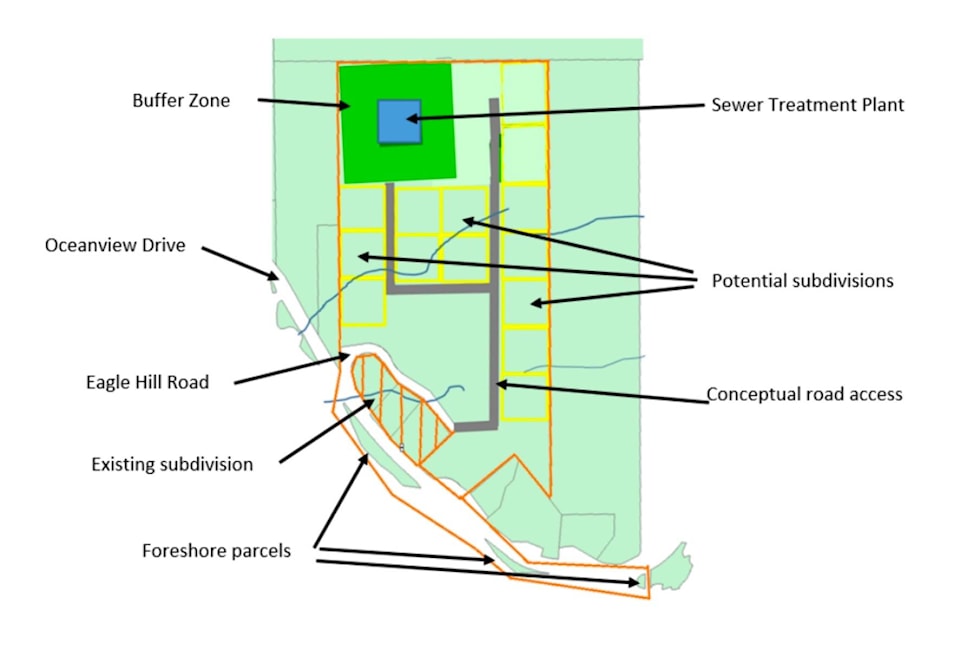It’s a terrible, horrible, no good, very bad way to deal with sewage.
For 33 years, sewage from Queen Charlotte has been ground up and pumped, untreated, into Bearskin Bay.
Environment Canada gave the village a Fisheries Act order to make plans for treating it by 2010, and to take “significant action” by 2020.
The question now is, should the village borrow money to buy a large $625,000 property on Martynuik Road for its future treatment plant?
Village councillors believe the site is the best of five options, but they will ask residents and property owners to make up their own minds in a referendum set for Feb. 24.
“I think it’s a great idea,” said Queen Charlotte Mayor Greg Martin. “It addresses two of our biggest problems.”
At 78 acres, the steeply sloping property at 4603 Martynuik Road has enough room to build a treatment plant up in its far northwest corner above Eagle Hill Road, while still leaving room for a number of houses on the tiered land down closer to Oceanview Drive.
Councillors could zone the area for “conservation-style” housing, meaning tiny homes, co-op homes, or other types of housing with a smaller than average footprint.
Judging by a town hall meeting held in April, Martin said getting sewage treatment may well be the number-one issue for village residents. Queen Charlotte now is the only village on Haida Gwaii that still discharges untreated sewage into the ocean.
“I had some seniors who are even older than I am at a table saying, ‘Why haven’t you done that? What’s wrong with you, you’re the mayor!” Martin said.
“They were outraged.”
Another top-of-mind issue is Queen Charlotte’s apparent lack of housing.
Several young couples have said they would prefer to buy or rent a home in Queen Charlotte, but are instead commuting from Tlell or Port Clements for lack of options.
Martin said village councillors would have built a sewage treatment plant a long time ago if only they had the money. Building a treatment plant on the Martynuik Road property would require detailed engineering work and an estimated $8.6 million — money that would have to come largely from the federal and provincial governments.
Even if the referendum passes and the plant is funded, it could be 2027 or longer before it’s up and running.
Before the plant is built, the village could subdivide the property, sell some for housing, and use those sales and others to pay down its $625,000 loan.
Council would also increase the overall property tax so that all properties — not only those with sewage services — help repay the loan. For a property worth $100,000, it would mean an annual tax increase of $29.75 starting in 2018.
Councillors will also consider selling the Kagan Bay log sort (while maintaining public beach access), and a small property just west of the helipad and boat launch that engineers judged too small for a treatment plant.
Martin, whose first high school job was actually driving an excavator and dump truck for an Illinois sewage plant, said there is always an “ick” factor when siting one, but they aren’t necessarily smelly.
He found no odours to complain about while touring the Port Edward plant this summer, and even back in his sewage-plant job of 1965, the only foul smell was the burning rubber at the tennis-shoe factory next door.
“It was hilarious,” he said. “Sewage workers complaining about tennis shoes.”
In an information sheet posted on the village website, staff list both pros and cons for the Martynuik Road site, as well as a map and cost estimates for four other options.
Among the pros, the site is well placed to connect Skidegate Landing and the BC Ferries terminal to sewer and water services. Only half of Queen Charlotte properties get sewage service today, while the rest rely on septic tanks and composting toilets.
The site is also well placed to discharge treated sewage into deep water.
The four other options considered by village staff and council, together with the cost estimates to build a plant are Smith Point ($6.8 million), central Queen Charlotte ($7.6 million), Skidegate Landing East ($9.4 million), or building a joint sewage treatment system with Skidegate ($14.2 million). The estimates are for plant construction only.
According to the eight criteria the village considered, the two areas best suited for the plant are Skidegate Landing East or Skidegate Landing West. Skidegate Landing West includes the Martynuik Road property.
While some have also suggested building the plant on industrial land west of Queen Charlotte, Martin said a 2013 engineering study “proved what every fisherman knows, that there are big mud flats there, and it’s not deep.”
“The outfall needs to go out to deep water and have a good tidal flush,” he said.
Among the cons for the Martynuik Road site is that building the plant up high on a slope will require expensive roadwork, and lots of pumping power. But staff hope to recoup some of the lost power by sending the treated wastewater through a turbine when it gets piped downhill and out to sea.
Lori Wiedeman, chief administrative officer for the village, said staff want a high voter turnout for the Feb. 24 referendum, and a lot of discussion beforehand.
Two coffee chats are planned at Queen B’s café, with the first on Nov. 28 from 2 to 4 p.m. and the next on Jan. 19, also from 2 to 4 p.m. Queen Charlotte council will hold a question-and-answer session on the issue, and an open house will be held at the Oceanview Restaurant on Feb. 8 from 7 to 9 p.m.
“We’re trying to share as much information as we can,” Wiedeman said. “We want people to have the information they need to make this decision.”
“Regardless of whether this property is selected or we need to move to a different option, we are going to have to deal with this as a municipality.”
